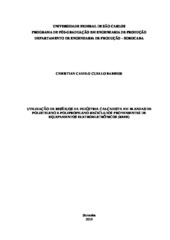| dc.contributor.author | Barrios, Christian Camilo Cuello | |
| dc.date.accessioned | 2020-02-19T14:11:08Z | |
| dc.date.available | 2020-02-19T14:11:08Z | |
| dc.date.issued | 2019-11-18 | |
| dc.identifier.citation | BARRIOS, Christian Camilo Cuello. Utilização de resíduos da indústria calçadista em blendas de polietileno e polipropileno reciclados provenientes de equipamentos eletroeletrônicos (REEE). 2019. Dissertação (Mestrado em Engenharia de Produção) – Universidade Federal de São Carlos, Sorocaba, 2019. Disponível em: https://repositorio.ufscar.br/handle/ufscar/12267. | * |
| dc.identifier.uri | https://repositorio.ufscar.br/handle/ufscar/12267 | |
| dc.description.abstract | A few years ago, a considerable increase occurred in the production, the consumption, and the generation rate of solid plastic waste (RSP). Waste electrical and electronic equipment (WEEE) falls into the category of high value and hazardousness, which is not appropriate to be disposed in landfills due to economic and environmental unfeasibility. On the other hand, fabrics and rubbers generated by the footwear industry are sent to landfills due to the difficulty of reintroduction in the production processes. In this context, the goal of the present work was the development of polymeric composites with the incorporation of different contents (10 and 20 wt%) of tennis residue (TW) in the recycled Polyethylene (PE) and Polypropylene (PP) blend from WEEE, compatibilized with Maleic Anhydride (MA). The materials were molded by extrusion-injection, and the composition with the best mechanical properties was also molded by hot compression, aiming to compare both molding methods and choose the more suitable productive method. For this, the developed mixtures were characterized by mechanical tests (flexural, tensile, impact and hardness), thermogravimetric analysis (TGA / DTG), differential scanning calorimetry (DSC) and scanning electron microscopy (SEM). The mixture with the best mechanical properties used 10% TW, 6% MA and PP/PE in equal proportion, improving both the flexural and the tensile strengths compared to the properties of untreated PE and PP polymers. An improvement in the impact resistance was observed due to the addition of TW and MA. Through thermal analysis, it was observed that the incorporation of TW in the PE/PP blend practically did not change the melting temperature. In this sense, the incorporation of TW into the PE/PP blend has shown satisfactory results, enabling the recycling of these three different wastes, while promoting the possibility of their reinsertion the productive process and providing information to allow the development of new products in the direction of the circular economy. | por |
| dc.description.sponsorship | Coordenação de Aperfeiçoamento de Pessoal de Nível Superior (CAPES) | por |
| dc.language.iso | por | por |
| dc.publisher | Universidade Federal de São Carlos | por |
| dc.rights | Attribution-NonCommercial-NoDerivs 3.0 Brazil | * |
| dc.rights.uri | http://creativecommons.org/licenses/by-nc-nd/3.0/br/ | * |
| dc.subject | Blendas | por |
| dc.subject | Compósitos Poliméricos | por |
| dc.subject | Polietileno Reciclado | por |
| dc.subject | Polipropileno Reciclado | por |
| dc.subject | Economia Circular | por |
| dc.subject | Gestão de Resíduos | por |
| dc.subject | REEE | por |
| dc.subject | Blends | por |
| dc.subject | Polymer Composites | por |
| dc.subject | Recycled Polyethylene | por |
| dc.subject | Recycled Polypropylene | por |
| dc.subject | Circular Economy | por |
| dc.subject | Waste Management | por |
| dc.subject | WEEE | por |
| dc.title | Utilização de resíduos da indústria calçadista em blendas de polietileno e polipropileno reciclados provenientes de equipamentos eletroeletrônicos (REEE) | por |
| dc.title.alternative | Use of footwear waste on PE/PP recycled blends from waste electrical and electronic equipment (WEEE) | por |
| dc.type | Dissertação | por |
| dc.contributor.advisor1 | Paiva, Jane Maria Faulstich De | |
| dc.contributor.advisor1Lattes | http://lattes.cnpq.br/7926832511513537 | por |
| dc.description.resumo | Há alguns anos, a produção, o consumo e a taxa de geração de resíduos sólidos plásticos (RSP) aumentaram consideravelmente. Os resíduos de equipamentos eletroeletrônicos (REEE) se enquadram na categoria de alto valor e periculosidade, não sendo adequado descartá-los em aterros devido à inviabilidade econômica e ambiental. Por outro lado, os tecidos e borrachas gerados pela indústria calçadista, são encaminhados aos aterros devido à dificuldade de reintrodução nos processos produtivos. Assim, o presente trabalho envolveu o desenvolvimento de compósitos poliméricos com a incorporação em distintas proporções (10 e 20%) de resíduo de tênis (RT) na blenda de Polietileno (PE) e Polipropileno (PP) reciclados provenientes de REEE, compatibilizados com Anidrido Maleico (AM). Os materiais foram moldados pelo método de extrusão-injeção e a mistura com melhores propriedades mecânicas também foi moldada pelo método de compressão a quente, com a intenção de comparar e escolher o método mais adequado de moldagem. Para isto, as misturas desenvolvidas foram caracterizadas através de ensaios mecânicos (flexão, tração, impacto e dureza), análise Termogravimétrica (TG/DTG), calorimetria exploratória diferencial (DSC) e Microscopia Eletrônica De Varredura (MEV). A mistura que apresentou melhores propriedades mecânicas utilizou 10% de RT, 6% de AM e PP/PE em igual proporção, melhorando a resistência à flexão e tração em comparação às propriedades dos polímeros PE e PP isolados. Foi observado aumento na resistência ao impacto devido à adição de RT e AM. Através da análise térmica foi observado que a incorporação do RT na blenda PE/PP praticamente não ocasionou alteração na temperatura de fusão. Neste sentido, a incorporação do RT na blenda PE/PP demonstrou resultados satisfatórios, viabilizando a reciclagem destes três diferentes resíduos, promovendo a possibilidade de reinserção no ciclo produtivo e fornecendo informações para o desenvolvimento de novos produtos na direção da economia circular. | por |
| dc.publisher.initials | UFSCar | por |
| dc.publisher.program | Programa de Pós-Graduação em Engenharia de Produção - PPGEP-So | por |
| dc.subject.cnpq | ENGENHARIAS::ENGENHARIA DE PRODUCAO::ENGENHARIA DO PRODUTO | por |
| dc.subject.cnpq | ENGENHARIAS::ENGENHARIA DE MATERIAIS E METALURGICA::MATERIAIS NAO METALICOS::POLIMEROS, APLICACOES | por |
| dc.description.sponsorshipId | CAPES: 001 | por |
| dc.publisher.address | Câmpus Sorocaba | por |
| dc.contributor.authorlattes | http://lattes.cnpq.br/1927757605801581 | por |


